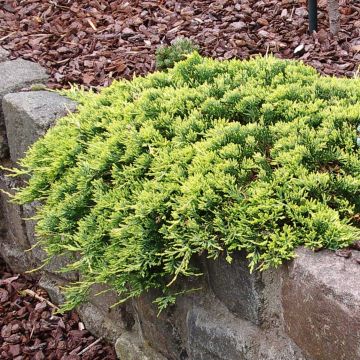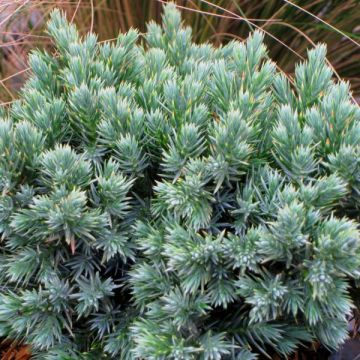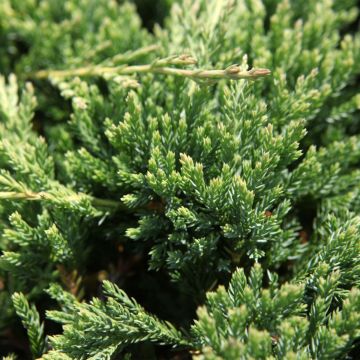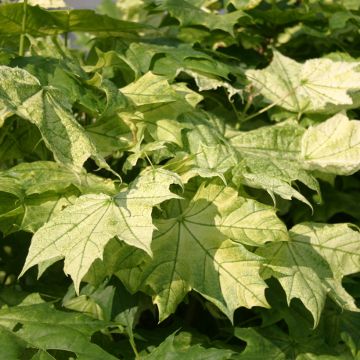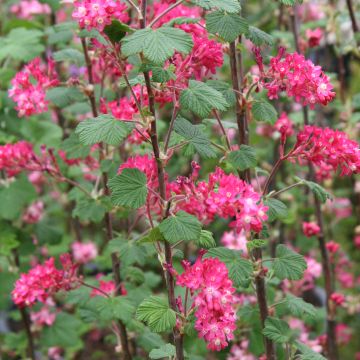

Juniperus sabina Tam No Blight
Juniperus sabina Tam No Blight
Juniperus sabina Tam No Blight
Savin Juniper, Sabine Juniper, Sabine
Why not try an alternative variety in stock?
View all →Order in the next for dispatch today!
Dispatch by letter from €3.90.
Delivery charge from €5.90 Oversize package delivery charge from €6.90.
Current delivery delay: 2 days.
More information
This item is not available in your country.
Schedule delivery date,
and select date in basket
This plant carries a 24 months recovery warranty
More information
We guarantee the quality of our plants for a full growing cycle, and will replace at our expense any plant that fails to recover under normal climatic and planting conditions.
From €5.90 for pickup delivery and €6.90 for home delivery
Express home delivery from €8.90.
Does this plant fit my garden?
Set up your Plantfit profile →
Description
Juniperus sabina 'Tam No Blight' is a variety of sabine juniper with beautiful dense blue-green foliage, evergreen all year round. It naturally adopts a spreading habit, forming a very good ground cover to dress a slope or decorate a rockery. Not bulky, it can also be used in borders, without the risk of invading its neighbors. It is a slow-growing conifer, but also an extremely hardy plant, perfectly adapted to wind, drought, and altitude. It prefers full sun and a well-drained soil, even poor, dry, and tolerant of limestone.
Also known as Savin, the Juniperus sabina is a mountain species native to Europe (Andalusia, Turkey, Alps, Balkans), North Africa (Algeria and Morocco), and Asia. It is found between 1400 and 2750m above sea level, but also in many parks and gardens in lowland where it has acclimated perfectly. It is a perfectly hardy conifer (down to -40°C) and of remarkable vigour belonging to the Cupressaceae family. Its short needles are not prickly, and in the absence of a defined axis, it develops in all directions in a bushy form, more or less creeping.
The 'Tam No Blight' cultivar forms after a few years a beautiful dense and prostrate shrub, measuring 60cm (23.6in) in height with a spread of 1.20m (3ft 11in). Beautiful with its beautiful blue-green colour, its evergreen foliage is decorative all year round. It grows slowly when young, then its growth accelerates somewhat as it ages. Its overlapping branches are covered with small tightly-packed scale-like leaves, pressed in pairs on the upright branchlets. Very sturdy, this small conifer is generally an undemanding plant to grow. However, note that junipers have a shallow root system that can sometimes make them difficult to associate with perennials.
The 'Tam No Blight' juniper is an extraordinary small conifer, very undemanding, that conquers space in the most difficult areas of the garden as long as they are sunny. It will be adopted without reservation on a difficult slope, among rocks, above a wall or a low wall, or near a swimming pool, as it goes well with geometric lines and masonry structures. It is easily cultivated in pots and lends itself well to the art of bonsai due to its very dense foliage and natural small size. Ideal in a contemporary garden, it can be associated with other graphic plants with colourful foliage, such as the Taxus baccata 'David', a columnar yew with young golden foliage, which will provide contrast in terms of shape and color. On a slope, it will blend well with the very pretty Cotoneaster suecicus 'Coral Beauty', with comparable vigour, and which will bring all the interest of beautiful white flowering, followed by magnificent decorative coral-coloured fruits.
Report an error about the product description
Plant habit
Foliage
Botanical data
Juniperus
sabina
Tam No Blight
Cupressaceae
Savin Juniper, Sabine Juniper, Sabine
Cultivar or hybrid
Other Juniperus - Juniper
Planting and care
Juniperus 'Tam No Blight' should be planted from September to November and from February to April in a very well-drained, light, even slightly chalky and poor soil. A stony or sandy soil that is occasionally dry does not bother it. Choose a very sunny location or, at most, partially shady. Soak the root balls well before planting. Add organic amendment at planting and water generously in the first years.
Apply a special conifer fertilizer every year in April and hoe the soil in summer. This very hardy conifer fears heavy, waterlogged soils in winter. Pruning is not necessary, but this conifer can be perfectly pruned to maintain a beautiful habit or form a bonsai. The old wood, devoid of needles, rarely regrows. If necessary, proceed from June to September.
Planting period
Intended location
Care
This item has not been reviewed yet - be the first to leave a review about it.
Foolproof Shrubs
Haven't found what you were looking for?
Hardiness is the lowest winter temperature a plant can endure without suffering serious damage or even dying. However, hardiness is affected by location (a sheltered area, such as a patio), protection (winter cover) and soil type (hardiness is improved by well-drained soil).

Photo Sharing Terms & Conditions
In order to encourage gardeners to interact and share their experiences, Promesse de fleurs offers various media enabling content to be uploaded onto its Site - in particular via the ‘Photo sharing’ module.
The User agrees to refrain from:
- Posting any content that is illegal, prejudicial, insulting, racist, inciteful to hatred, revisionist, contrary to public decency, that infringes on privacy or on the privacy rights of third parties, in particular the publicity rights of persons and goods, intellectual property rights, or the right to privacy.
- Submitting content on behalf of a third party;
- Impersonate the identity of a third party and/or publish any personal information about a third party;
In general, the User undertakes to refrain from any unethical behaviour.
All Content (in particular text, comments, files, images, photos, videos, creative works, etc.), which may be subject to property or intellectual property rights, image or other private rights, shall remain the property of the User, subject to the limited rights granted by the terms of the licence granted by Promesse de fleurs as stated below. Users are at liberty to publish or not to publish such Content on the Site, notably via the ‘Photo Sharing’ facility, and accept that this Content shall be made public and freely accessible, notably on the Internet.
Users further acknowledge, undertake to have ,and guarantee that they hold all necessary rights and permissions to publish such material on the Site, in particular with regard to the legislation in force pertaining to any privacy, property, intellectual property, image, or contractual rights, or rights of any other nature. By publishing such Content on the Site, Users acknowledge accepting full liability as publishers of the Content within the meaning of the law, and grant Promesse de fleurs, free of charge, an inclusive, worldwide licence for the said Content for the entire duration of its publication, including all reproduction, representation, up/downloading, displaying, performing, transmission, and storage rights.
Users also grant permission for their name to be linked to the Content and accept that this link may not always be made available.
By engaging in posting material, Users consent to their Content becoming automatically accessible on the Internet, in particular on other sites and/or blogs and/or web pages of the Promesse de fleurs site, including in particular social pages and the Promesse de fleurs catalogue.
Users may secure the removal of entrusted content free of charge by issuing a simple request via our contact form.
The flowering period indicated on our website applies to countries and regions located in USDA zone 8 (France, the United Kingdom, Ireland, the Netherlands, etc.)
It will vary according to where you live:
- In zones 9 to 10 (Italy, Spain, Greece, etc.), flowering will occur about 2 to 4 weeks earlier.
- In zones 6 to 7 (Germany, Poland, Slovenia, and lower mountainous regions), flowering will be delayed by 2 to 3 weeks.
- In zone 5 (Central Europe, Scandinavia), blooming will be delayed by 3 to 5 weeks.
In temperate climates, pruning of spring-flowering shrubs (forsythia, spireas, etc.) should be done just after flowering.
Pruning of summer-flowering shrubs (Indian Lilac, Perovskia, etc.) can be done in winter or spring.
In cold regions as well as with frost-sensitive plants, avoid pruning too early when severe frosts may still occur.
The planting period indicated on our website applies to countries and regions located in USDA zone 8 (France, United Kingdom, Ireland, Netherlands).
It will vary according to where you live:
- In Mediterranean zones (Marseille, Madrid, Milan, etc.), autumn and winter are the best planting periods.
- In continental zones (Strasbourg, Munich, Vienna, etc.), delay planting by 2 to 3 weeks in spring and bring it forward by 2 to 4 weeks in autumn.
- In mountainous regions (the Alps, Pyrenees, Carpathians, etc.), it is best to plant in late spring (May-June) or late summer (August-September).
The harvesting period indicated on our website applies to countries and regions in USDA zone 8 (France, England, Ireland, the Netherlands).
In colder areas (Scandinavia, Poland, Austria...) fruit and vegetable harvests are likely to be delayed by 3-4 weeks.
In warmer areas (Italy, Spain, Greece, etc.), harvesting will probably take place earlier, depending on weather conditions.
The sowing periods indicated on our website apply to countries and regions within USDA Zone 8 (France, UK, Ireland, Netherlands).
In colder areas (Scandinavia, Poland, Austria...), delay any outdoor sowing by 3-4 weeks, or sow under glass.
In warmer climes (Italy, Spain, Greece, etc.), bring outdoor sowing forward by a few weeks.



































